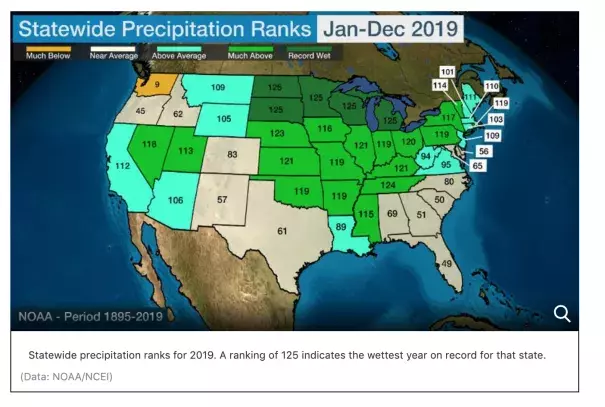2019 Was Second-Wettest Year on Record in the U.S., Warmest Year in Alaska, NOAA Says

Signals Summary: Climate change is increasing the frequency and intensity of extreme precipitation events, and in some places, including the Midwest, it is increasing the overall amount of precipitation.
Article Excerpt: The contiguous United States had its second-wettest year on record in 2019, and it was the warmest year ever recorded in Alaska, according to NOAA's 2019 U.S. climate report released Wednesday.
The annual precipitation total for the Lower 48 was 34.78 inches, 4.84 inches above the 20th century average, ranking as the second-wettest year on record. 2019 was only 0.18 inches away from tying the nation's wettest year of 1973, NOAA said.
Record amounts of precipitation – including rain plus melted snow and ice – were observed in the Great Lakes, Northern Plains and parts of the Central Plains. The seven wettest 12-month periods in U.S. history all included a portion of 2019.
Much of the country was wetter than average last year. The wettest parts of the nation included the Plains, Midwest, Mississippi and Ohio valleys, Northeast and portions of the West. North Dakota, South Dakota, Minnesota, Wisconsin and Michigan all had their wettest year on record in 2019, according to NOAA.
...
For the first time on record, Alaska's annual average temperature was above freezing (32.2 degrees), 6.2 degrees above the long-term average, making it the warmest year ever recorded in the state. The previous record-warm year was 2016 (31.9 degrees).
Four of the last six years in Alaska have been record-warm. Utqiaġvik (Barrow), Kotzebue, King Salmon, Fairbanks, Bethel, Anchorage, Northway, McGrath, Kodiak and Cold Bay all had the warmest year on record in 2019, NOAA said.
Record to near-record warmth was observed across northern and central parts of Alaska, with the coolest – yet, still above average – temperatures confined to the western Aleutians and eastern Panhandle. On the Fourth of July, Anchorage reported its first 90-degree temperature on record.


